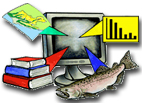Bibliography Background About KRIS
Pesticides Effects on Salmon, Steelhead and Trout
The passage below is taken from Ewing, R.D. 1999. Diminishing Returns: Salmon Decline and Pesticides. Funded by the Oregon Pesticide Education Network, Biotech Research and Consulting, Inc., Corvallis, OR. 55 p.
Fish Kills and Acute Toxicity of Pesticides to Salmon
Pesticides are capable of killing salmon and other aquatic life directly and within a short period of time. For example, in 1996 the herbicide acrolein was responsible for the death of approximately 92,000 steel-head, 114 juvenile coho salmon, 19 resident rainbow trout, and thousands of non-game fish in Bear Creek, a tributary of the Rogue River. Deaths of threatened and endangered species from accidental contamination of waterways are of grave concern. The loss of each individual in a sensitive population makes recovery efforts that much more difficult. Fortunately, these deaths are relatively infrequent.
Behavioral Effects of Pesticides at Sublethal Concentrations
In contrast to dramatic fish kills, the effects of sublethal concentrations of pesticides are more subtle and go largely unseen and unregulated. Sublethal concentrations of pesticides do not cause immediate death, but can interfere with the biology of the organism in other ways and can ultimately impact the survival of the species. Laboratory studies show that sublethal concentrations of pesticides can affect many aspects of salmon biology, including a number of behavioral effects:
• Long-term exposure to certain pesticides can increase stress in juvenile salmonids and thereby render them more susceptible to predation.
• Certain pesticides can alter swimming ability, which in turn can reduce the ability to feed, to avoid predators, to defend territories, and to maintain position in the river system.
• Many pesticides interrupt schooling behavior, a critical tactic for avoiding predation, during salmon migration. Disruption of schooling behavior is thought by some researchers to be a classic method for examining sublethal effects of pesticides because the effect is so common.
• Several pesticides (and other pollutants) have been shown to cause fish to seek sub-optimal water temperatures, thus subjecting them to increased dangers of disease and predation.
• Some herbicides have been shown to inhibit normal migration to the sea, resulting in severe disruption of the life cycle. There is a dearth of research looking at this effect for common insecticides.
• Several studies suggest that certain pesticides can impair salmonid’s ability to transition from freshwater to seawater.There is a need for further research in this area, placing particular emphasis on the critical period of transition that takes place in the estuary.
• Adult salmon adjust their migration patterns to avoid polluted areas, resulting in delayed spawning.
Compromised Immune Systems
In addition to changes in behavior, exposure to relatively low concentrations of pesticides can disrupt the immune system of salmon. Evidence for these effects in salmonids is not as extensive as for disruption of behavior, but the data available suggest that pesticides can have serious negative impacts on the immune system. Such disruption results in the onset of disease and even death.
Endocrine Disruptors
Fish and other organisms are especially vulnerable to endocrine-disrupting effects during the early stages of development. Pesticides at low concentrations may act as mimics or blockers of sex hormones, causing abnormal sexual development, feminization of males, abnormal sex ratios, and unusual mating behavior. The unique plasticity of sex differentiation in fish suggests that these animals may be very susceptible to disruption of sexual characteristics by pollutants. Pesticides can also interfere with other hormonal processes, such as thyroid functioning and bone development.
Indirect Effects of Pesticides on Salmon
Pesticides can indirectly affect fish by interfering with their food supply or altering the aquatic habitat, even when the concentrations are too low to affect the fish directly. Such indirect effects greatly reduce the abundance of food organisms which in turn reduces the growth and probability of survival of the fish. In addition, removal of aquatic vegetation can decrease habitat suitability and increase the salmon’s susceptibility to predation. These indirect effects are subtle, but evidence suggests that in complex ecosystems indirect effects can be even more important than direct effects.
